 W
WThe AEECL's sportive lemur, Antafia sportive lemur or red-shouldered sportive lemur is a sportive lemur endemic to Madagascar. It has a total length of about 52 to 59 cm, of which 24–26 cm (9.4–10.2 in) are tail. AEECL's sportive lemur is found in western Madagascar, living in dry deciduous forests.
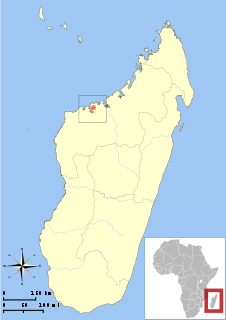 W
WAhmanson's sportive lemur, or the Tsiombikibo sportive lemur, is a sportive lemur endemic to Madagascar. It is a relatively small sportive lemur with a total length of about 47 to 54 cm, of which 23–25 cm (9.1–9.8 in) are tail. Wright's sportive lemur is found in western Madagascar, living in dry forests.
 W
WThe Ankarana sportive lemur, or Ankarana weasel lemur, is a sportive lemur endemic to Madagascar. It is one of the smaller sportive lemurs with a total length of about 53 cm (21 in), including 25 cm (9.8 in) of tail. Average body weight is approximately 750 grams (1.65 lb). The Ankarana sportive lemur is found in northern Madagascar, living in dry lowland forests in Ankarana, Andrafiamena and Analamerana, and in moist montane forest of Montagne d'Ambre.
 W
WThe Bemaraha woolly lemur, also known as Cleese's woolly lemur, is a species of woolly lemur native to western Madagascar, named after John Cleese. The first scientist to discover the species named it after Cleese, star of Monty Python, mainly because of Cleese's fondness for lemurs, as shown in Operation Lemur With John Cleese and Fierce Creatures, and his efforts at protecting and preserving them. The species was first recorded in 1990 by a team of scientists from Zurich University led by Urs Thalmann, but wasn't formally described as a species until November 11, 2005.
 W
WThe betsileo sportive lemur is a sportive lemur endemic to Madagascar. It is a relatively large sportive lemur with a total length of about 58 to 27 cm, of which 32 to 33 cm are tail. The betsileo sportive lemur is found in eastern Madagascar, living in primary and secondary rainforests.
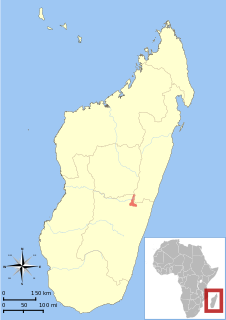 W
WThe Betsileo woolly lemur or Betsileo avahi is a species of woolly lemur native to southeastern Madagascar, in the District of Fandriana. It weighs about 1 kg. The pelage differs significantly from other southeastern woolly lemurs in that it is primarily light reddish brown on most of the body and grey under the jaw and on the extremities. The pelage is thicker on the head than other eastern woolly lemurs.
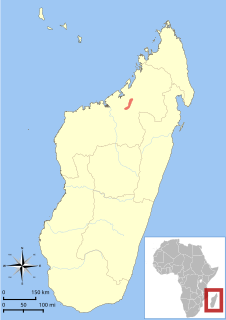 W
WThe Bongolava mouse lemur is a species of mouse lemur endemic to Madagascar. It lives in western deciduous forest within a limited range, including Bongolava Forest and Ambodimahabibo Forest between the Sofia River and the Mahajamba River. It is a relatively large mouse lemur with a total length of 26 to 29 centimetres, including 15 to 17 centimeters of tail.
 W
WCoquerel's giant mouse lemur, also known as Coquerel's dwarf lemur or the southern giant mouse lemur, is a small nocturnal lemur endemic to Madagascar. This species can be found in parts of the Madagascar dry deciduous forests.
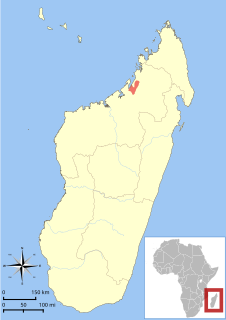 W
WDanfoss' mouse lemur, or the Ambarijeby mouse lemur, is a species of mouse lemur endemic to Madagascar. It lives in western deciduous forest within a limited range between the Sofia River and the Maevarano River. It is a relatively large reddish mouse lemur with a total length of 25 to 29 centimeters, including 15 to 17 centimeters of tail.
 W
WThe Daraina sportive lemur is a sportive lemur endemic to Madagascar. It is a relatively small sportive lemur with a total length of about 49 to 56 cm, of which 24–27 cm (9.4–10.6 in) are tail.
 W
WThe eastern woolly lemur, also known as the eastern avahi or Gmelin's woolly lemur, is a species of woolly lemur native to eastern Madagascar, where it lives in the wet tropical rainforest at low elevations along the eastern coast of the island or they can also inhabit the northern tip of the island with other species. The woolly lemur name refers to their thick, tightly-curled hair, whereas their generic name avahi refers to their high-pitched defensive call. The eastern woolly lemur almost has an owl-look with its large eyes, small rounded head, and ears that are mostly hidden. This nocturnal animal weighs 1.0–1.3 kg and reaches a length of 27–29 cm with a tail of 33–37 cm. Its diet consists mainly of leaves and buds with fruits, flowers, and bark.
 W
WFleurete's sportive lemur, or the Andohahela sportive lemur, is a sportive lemur endemic to Madagascar. It is a medium-sized sportive lemur with a total length of about 58 to 67 cm, of which about 30 cm (12 in) in are tail Fleurete's sportive lemur is found in southeastern Madagascar, living in primary and secondary rainforests.
 W
WThe furry-eared dwarf lemur, or Crossley's dwarf lemur, only found on the island of Madagascar, as with all other lemurs. It has a pelage coloration that is red-brown dorsally and gray ventrally. The eye-rings of this species are blackish and the ears are black inside and out.
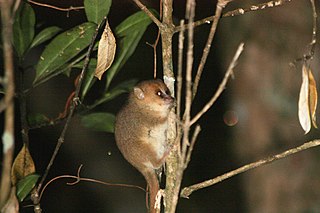 W
WGoodman's mouse lemur is a species of mouse lemur from the region near Andasibe in eastern Madagascar. The species is named in honor of primatologist Steven M. Goodman. "Lehilahytsara" is a combination of the Malagasy words which mean "good" and "man". The finding was presented August 10, 2005, along with the discovery of the northern giant mouse lemur as a separate species.
 W
WThe gray-backed sportive lemur, also known as Gray's sportive lemur or back-striped sportive lemur, is a species of lemur in the family Lepilemuridae. It is endemic to Madagascar. It is threatened by habitat loss.
 W
WThe gray-headed lemur, or gray-headed brown lemur, is a medium-sized primate, a cathemeral species of lemur in the family Lemuridae. Until a taxonomic revision in 2008, it was known as the white-collared brown lemur or white-collared lemur. It lives in south-eastern Madagascar. In 2005, satellite imagery estimates showed approximately 700 km2 (270 sq mi) of total remaining habitat within its geographic range. It is highly threatened by hunting and habitat loss, and was considered to be among the 25 most endangered primates in 2006–2008. It is currently listed as Critically Endangered by the International Union for Conservation of Nature (IUCN) due to a highly restricted range, and has been named one of "The World's 25 Most Endangered Primates."
 W
WGrewcock's sportive lemur, or the Anjiamangirana sportive lemur, is a sportive lemur endemic to Madagascar. It is a medium-sized sportive lemurs with a total length of about 55 to 63 cm, of which 26–30 cm (10–12 in) are tail. Grewcock's sportive lemur is found in northwestern Madagascar, living in dry deciduous forests.
 W
WGroves' dwarf lemur is a species of dwarf lemur known from Ranomafana and Andringitra national parks and surrounding areas in southeastern Madagascar. The identification was based on comparison of mitochondrial and nuclear gene sequences with other members of the C. crossleyi group. Individuals from this clade first came under genetic study in 1999 and were recognized as a new species in 2014, but it was not formally described until 2017. The lemur was named after mammalologist Colin Groves. Known from altitudes from 754 to 999 m, it is significantly larger than other members of the C. crossleyi group, with a 20 cm body length, a 29 cm tail, and a weight of 0.41 kg. While the conservation status of the new species has not yet been assessed, its presence in several national parks does not guarantee that it will not be threatened by deforestation ongoing on the island, or possibly by hunting.
 W
WHawks' sportive lemur, also known as the Nosy Be sportive lemur or Nosy Be weasel lemur, is a sportive lemur endemic to Madagascar. It is a moderately large sportive lemur, with a total length of about 50 to 68 cm, of which 22 to 27 cm are tail.
 W
WHolland's sportive lemur, or the Mananara-Nord sportive lemur, is a sportive lemur that is endemic to Madagascar. It is one of 26 species in the genus Lepilemur. This lemur is found specifically in the Mananara-Nord Biosphere Reserve, but the limits of its habitat have yet to be determined. It lives in primary and secondary rainforests. Holland's sportive lemur was described in 2008.
 W
WHubbard's sportive lemur, or the Zombitse sportive lemur, is a sportive lemur endemic to Madagascar. It has total length of about 51 to 59 cm, of which 23–25 cm (9.1–9.8 in) are tail. Hubbard's sportive lemur is found in southwestern Madagascar, living in dry transitional forests. Zombitse-Vohibasia National Park is the only protected area it is documented in. "This species is threatened by habitat loss and degradation from shifting agriculture, as well as unsustainable levels of hunting."
 W
WJames' sportive lemur, or the Manombo sportive lemur, is a sportive lemur endemic to Madagascar. It is one of the larger sportive lemurs with a total length of about 60 to 67 cm, of which 28 to 32 cm are tail. James' sportive lemur is found in southeastern Madagascar, living in primary and secondary lowland forests.
 W
WJovian was a lemur, best known for portraying Zoboomafoo in the series of the same name. Jovian sometimes shared the title role with his father.
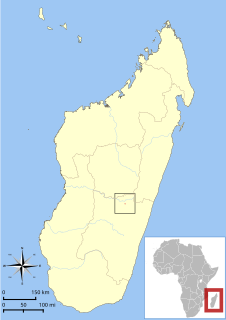 W
WThe lesser iron-gray dwarf lemur, or large iron-gray dwarf lemur, is a small nocturnal lemur endemic to Madagascar. It is nocturnal and an arboreal quadruped, and is not very agile. It produces three types of vocalisation: a squeak, which is high in pitch and is produced with the mouth closed, and is used between infants and their mothers; a whistle, which is higher in pitch than the squeak, so it is hard to hear with human ears, and is used as a communicative and possibly territorial call; and a grunt, which is usually given in series and is very powerful, used when an individual is being attacked in its nest.
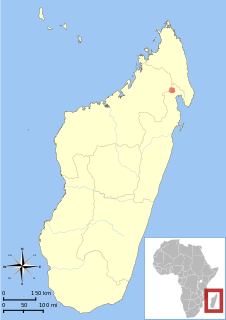 W
WMacArthur's mouse lemur, or the Anjiahely mouse lemur, is a species of mouse lemur known only from Makira Natural Park in northeastern Madagascar.
 W
WMilne-Edwards' sportive lemur, or Milne-Edwards' weasel lemur, is a species of lemur in the family Lepilemuridae. It is endemic to Madagascar. Its natural habitat is subtropical or tropical dry forests. It is threatened by habitat loss.
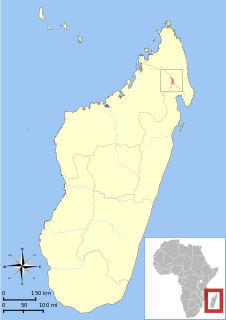 W
WMittermeier's mouse lemur is a species of mouse lemur known only from Anjanaharibe-Sud Special Reserve in Madagascar. The species is named in honor of primatologist Russell Mittermeier, who is President of Conservation International.
 W
WMittermeier's sportive lemur is a sportive lemur endemic to the Ampasindava Peninsula in Madagascar.
 W
WMoore's woolly lemur, or the Masoala woolly lemur, is a woolly lemur endemic to Madagascar. It has brown-grey fur and a reddish tail. It is named in honor of the Gordon and Betty Moore Foundation of San Francisco.
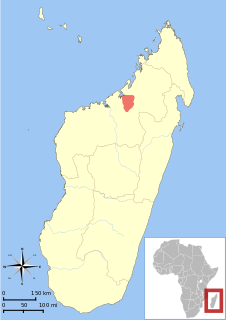 W
WOtto's sportive lemur, or the Ambodimahabibo sportive lemur, is a sportive lemur endemic to Madagascar. Its coloration is primarily grey-brown. It is known only from Ambodimahabibo, between the Mahajamba River in the west and the Sofia River in the north.
 W
WThe pale fork-marked lemur, or western fork-marked lemur, is known from western Madagascar; south of the Fiherenana River to the region of Soalala. It is listed on CITES Appendix I.
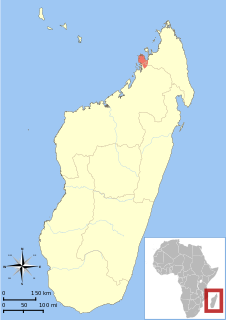 W
WPariente's fork-marked lemur, or the Sambirano fork-marked lemur is a species of lemur endemic to the Sambirano region of north-western Madagascar. This lemur has light brown to gray upperparts, a prominent facial fork and dorsal stripe that runs from the tail's tip to the point where it splits on the lemur's head to rejoin at the nose, and a white-tipped tail. It is found in lowland and mid-altitude humid forests and is nocturnal. It is an omnivore, eating tree gum, sap, bud exudes, insects and larvae. It sleeps in nests that have been abandoned by other lemurs, particularly Coquerel's giant mouse lemur. This species is relatively unknown, though it is threatened by habitat destruction. It was previously considered a subspecies of the Masoala fork-marked lemur. It is listed on CITES Appendix I.
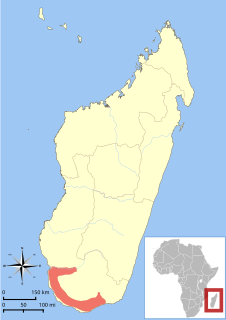 W
WPetter's sportive lemur is a sportive lemur endemic to Madagascar. It is one of 26 species in the genus Lepilemur. It is one of the smaller sportive lemurs with a total length of about 49 to 54 cm, of which 22–25 cm (8.7–9.8 in) are tail. Petter's sportive lemur is found in southwestern Madagascar, living in dry spiny forests and some gallery forests.
 W
WPeyrieras's woolly lemur or Peyrieras's avahi is a species of woolly lemur native to southeastern Madagascar. It weighs about 1 kg.
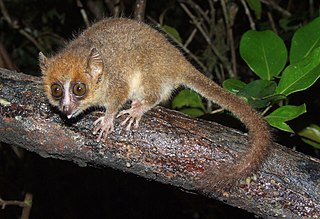 W
WThe pygmy mouse lemur, also known as Peters' mouse lemur or dormouse lemur, is a primate weighing only 43–55 g (1.5–1.9 oz); it is the second smallest of the mouse lemurs. Its dorsal side is a rufous-brown colour, and creamy-white ventrally. It lives in dry deciduous forests.
 W
WRamanantsoavana's woolly lemur, also known as Ramanantsoavana's avahi or the Manombo woolly lemur, is a species of woolly lemur native to southeastern Madagascar. It weighs about 1 kg. It was originally considered a subspecies of the southern woolly lemur, A. m. ramanantsoavana, but was elevated to a separate species in 2006 based on molecular, phenotypic and morphological data.
 W
WRandrianasolo's sportive lemur, or the Bemaraha sportive lemur, is a sportive lemur endemic to Madagascar. It has a total length of about 49 to 56 cm, of which 21–26 cm (8.3–10.2 in) are tail. Randrianasolo's sportive lemur is found in western Madagascar.
 W
WThe red-tailed sportive lemur, or red-tailed weasel lemur, is native to Madagascar like all lemurs. It is a nocturnal species feeding largely on leaves, though they also eat some fruit. Individuals weigh around 800 g (1.8 lb), and there is little sexual dimorphism. In general they live in mated pairs, with a home range of about 10,000 square metres. Both members of the pair use the same home range, and there is little overlap between the home ranges of neighbouring pairs. Travel distances each night are between 100 m (330 ft) and 1 km (0.6 mi), making this a relatively inactive species. This species can be found in the Madagascar dry deciduous forests.
 W
WThe Sambirano mouse lemur is a small, recently discovered primate and like the other mouse lemurs can only be found on the island of Madagascar. The dorsal side is both cinnamon and rufous-cinnamon and is grey ventrally. It has vibrissae that are dark in color.
 W
WThe Sambirano woolly lemur, also known as the Sambirano avahi or unicolor woolly lemur, is a species of woolly lemur native to western Madagascar.
 W
WScott's sportive lemur, or the Masoala sportive lemur, is a sportive lemur endemic to Madagascar. This is one of 26 species in the genus Lepilemur. It has greyish brown fur and a black-tipped tail. It is named in honor of the Suzanne and Walter Scott Jr. Foundation.
 W
WSeal's sportive lemur, or the Anjanaharibe-Sud sportive lemur, is a sportive lemur endemic to Madagascar. It is a large sportive lemur with a total length of about 57 to 64 cm, of which 25 to 28 cm are tail. Seal's sportive lemur is found in northeastern Madagascar, living in primary and secondary mid-altitude rainforests.
 W
WSibree's dwarf lemur is a small nocturnal lemur endemic to Madagascar.
 W
WVon der Decken's sifaka is a sifaka endemic to Madagascar. It has a length of 92 to 107 centimeters, of which 42-48 centimeters are tail. Von der Decken's Sifaka lives in western Madagascar. It lives in dry deciduous forest.
 W
WWright's sportive lemur, or the Kalambatritra sportive lemur, is a sportive lemur endemic to Madagascar. It is one of the larger sportive lemurs with a total length of about 52 to 64 cm, of which 24–27 cm (9.4–10.6 in) are tail. Wright's sportive lemur is found in southeastern Madagascar, living in primary and secondary mid-altitude forests.